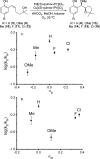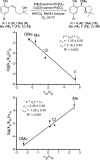Advancing the mechanistic understanding of an enantioselective palladium-catalyzed alkene difunctionalization reaction
- PMID: 21082845
- PMCID: PMC3066298
- DOI: 10.1021/ja108106h
Advancing the mechanistic understanding of an enantioselective palladium-catalyzed alkene difunctionalization reaction
Abstract
The mechanism of an enantioselective palladium-catalyzed alkene difunctionalization reaction has been investigated. Kinetic analysis provides evidence of turnover-limiting attack of a proposed quinone methide intermediate with MeOH and suggests that copper is involved in productive product formation, not just catalyst turnover. Through examination of substrate electronic effects, a Jaffé relationship was observed correlating rate to electronic perturbation at two positions of the substrate. Ligand effects were evaluated to provide evidence of rapid ligand exchange between palladium and copper as well as a correlation between ligand electronic nature and enantioselectivity.
Figures


















Similar articles
-
Palladium-catalyzed enantioselective addition of two distinct nucleophiles across alkenes capable of quinone methide formation.J Am Chem Soc. 2009 Dec 2;131(47):17074-5. doi: 10.1021/ja909030c. J Am Chem Soc. 2009. PMID: 19902942 Free PMC article.
-
Synthesis and preliminary biological studies of 3-substituted indoles accessed by a palladium-catalyzed enantioselective alkene difunctionalization reaction.J Am Chem Soc. 2010 Jun 16;132(23):7870-1. doi: 10.1021/ja103472a. J Am Chem Soc. 2010. PMID: 20486685 Free PMC article.
-
Mechanistic Model for Enantioselective Intramolecular Alkene Cyanoamidation via Palladium-Catalyzed C-CN Bond Activation.J Org Chem. 2017 Apr 7;82(7):3721-3726. doi: 10.1021/acs.joc.7b00196. Epub 2017 Mar 15. J Org Chem. 2017. PMID: 28294618 Free PMC article.
-
Palladium(II)-catalyzed alkene functionalization via nucleopalladation: stereochemical pathways and enantioselective catalytic applications.Chem Rev. 2011 Apr 13;111(4):2981-3019. doi: 10.1021/cr100371y. Epub 2011 Mar 23. Chem Rev. 2011. PMID: 21428440 Free PMC article. Review. No abstract available.
-
Dehydrogenative Pd and Ni Catalysis for Total Synthesis.Acc Chem Res. 2021 Mar 2;54(5):1118-1130. doi: 10.1021/acs.accounts.0c00787. Epub 2021 Feb 16. Acc Chem Res. 2021. PMID: 33592147 Free PMC article. Review.
Cited by
-
Second-Generation Palladium Catalyst System for Transannular C-H Functionalization of Azabicycloalkanes.J Am Chem Soc. 2018 Apr 25;140(16):5599-5606. doi: 10.1021/jacs.8b02142. Epub 2018 Apr 13. J Am Chem Soc. 2018. PMID: 29652497 Free PMC article.
-
A palladium-catalyzed three-component cross-coupling of conjugated dienes or terminal alkenes with vinyl triflates and boronic acids.J Am Chem Soc. 2011 Apr 20;133(15):5784-7. doi: 10.1021/ja201358b. Epub 2011 Mar 30. J Am Chem Soc. 2011. PMID: 21449562 Free PMC article.
-
Mechanistic study on the side arm effect in a palladium/Xu-Phos-catalyzed enantioselective alkoxyalkenylation of γ-hydroxyalkenes.Nat Commun. 2023 Nov 22;14(1):7611. doi: 10.1038/s41467-023-43202-5. Nat Commun. 2023. PMID: 37993423 Free PMC article.
-
Palladium-catalyzed hydrofunctionalization of vinyl phenol derivatives with heteroaromatics.Org Lett. 2011 May 20;13(10):2774-7. doi: 10.1021/ol200913r. Epub 2011 Apr 21. Org Lett. 2011. PMID: 21510631 Free PMC article.
-
Copper-Catalyzed Enantioselective Aerobic Alkene Aminooxygenation and Dioxygenation: Access to 2-Formyl Saturated Heterocycles and Unnatural Proline Derivatives.J Am Chem Soc. 2023 Jun 28;145(25):13715-13729. doi: 10.1021/jacs.3c01985. Epub 2023 Jun 16. J Am Chem Soc. 2023. PMID: 37327484 Free PMC article.
References
-
- Kolb HC, VanNieuwenhze MS, Sharpless KB. Chem. Rev. 1994;94:2483.
-
- Cardona F, Goti A. Nat. Chem. 2009;1:269. - PubMed
-
- Bäckvall J-E. Met.-Catal. Cross-Coupling React. (2nd Ed.) 2004;2:479.
Publication types
MeSH terms
Substances
Grants and funding
LinkOut - more resources
Full Text Sources

